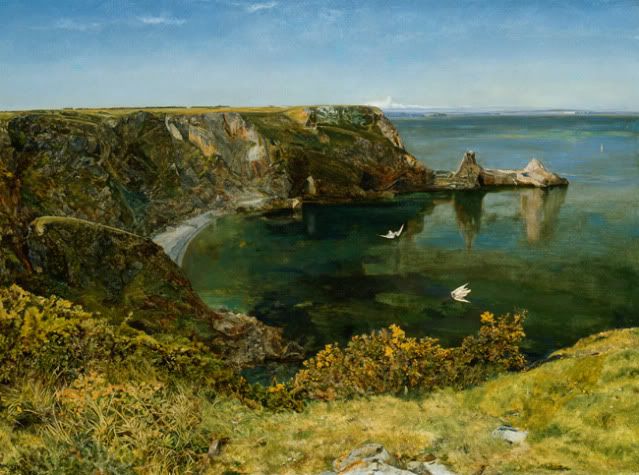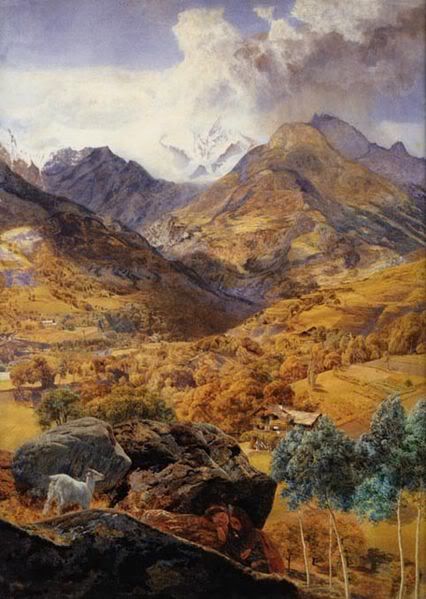Friday, January 7, 2011
The Poetry of Drawing: Pre-Raphaelite Designs, Studies and Watercolours
The Poetry of Drawing will include pieces from the most prominent members of the Pre-Raphaelite movement, including all the original members of the PRB, Elizabeth Siddal, Edward Burne-Jones, Frederick Sandys and Simeon Solomon. Later artists, such as Aubrey Beardsley, who were influenced by the Brotherhood are also included, as are the Arts and Crafts contributions of William Morris, William de Morgan and Florence Camm.
For those of you who are unable to attend, the exhibition's curator has created an illustrated volume entitled Pre-Raphaelite Drawing. The book will be published by Thames and Hudson. I would love to see this exhibit in person, but if I don't get the chance, I will definitely be looking into the catalogue!
For more information and ticket prices, please visit the Birmingham Museum's exhibition website.
Image above is William Morris' sketch for his Trellis wallpaper design.
Posted by
Margaret
at
3:13 PM
4
comments
![]()
![]()
Labels: edward burne-jones, frederick sandys, lizzie siddal, millais, museums, news, pre-raphaelites, rossetti, william holman hunt, william morris
Monday, November 22, 2010
Did the Pre-Raphaelites Suffer from "Blurred Vision?"
This morning I came across a less-than-enthused review of "The Pre-Raphaelite Lens" in the Washington Post. In the article, Andy Grundberg criticized what he termed the "blurred vision" of the Pre-Raphaelites. And while Grundberg retained some admiration for the work done by Pre-Raphaelite landscape artists, he condemned the Brotherhood with broad strokes, arguing that "its members claimed to be interested in realism and truth" but were "far more taken with notions of fiction and theatricality."
Grundberg was a photography critic for the New York Times for many years, so it's not surprising that he prefers the Pre-Raphaelites landscapes and photography to their paintings. But his criticism of the PRB is pretty standard. Many modern viewers can appreciate the work of artists like John William Inchbold (whose photograph-quality painting of Anstey's Cove is pictured here), and even Ford Maddox Brown, but remain perplexed by the romanticism of Dante Gabriel Rossetti and Sir Edward Coley Burne-Jones.
I was particularly struck by Grundberg's backhanded compliment that Julia Margaret Cameron and Henry Peach Robinson had "managed against odds to transcend their subjects' goofy origins in Arthurian legend." So now it's "goofy" to be inspired by myths and legend? Greek myth has inspired countless artists and is (quite rightly) not regarded as a "goofy" source of inspiration. Why should ancient British myths be seen differently?
Mythology is such a rich source of inspiration for artists, and it saddens me to see it dismissed off-hand. Many members of the PRB were actually very interested in a "modern" approach to art and design. They recognized that British art had become mired in convention and instead attempted to use the classics as a foundation to build from that would allow them break free from traditions that had become oppressive to artists. Even William Morris, whose passion for the middle ages is well-known, was not attempting to imitate medieval design, but to use it as a source of inspiration to create a better future.
Apparently, people today are confused that a a group that claimed to be visionary would lean so heavily on mythology and the classics for inspiration. Contemporary artists and (and their adoring critics) have the hubris to claim that they have re-invented the wheel, or are totally unencumbered by the influence of others from the past (the Young British Artists come to mind). And while this unfettered arrogance is intriguing, and can sometimes produce fascinating work, it also runs the risk of alienating the public with its hollow promise of unbridled innovation. A connection to the past and an understanding of our collective unconscious is not "goofy" - it's a fundamental part of the creative process.
Posted by
Margaret
at
4:08 PM
14
comments
![]()
![]()
Labels: Arthurian legend, edward burne-jones, medieval, mythology, pre-raphaelites, rossetti, william morris
Thursday, September 16, 2010
Pre-Raphaelite exhibits at Oxford and Cambridge: Pre-Raphaelites and Italy and Pre-Raphaelite Portraits by John Brett
My family and I enjoyed a wonderful--if slightly frenetic--weekend visiting family in Washington state. It was quite the whirlwind weekend - shopping, a wedding and visiting a couple of friends. We had a great time though. Seattle is a beautiful city, and Washington is so pretty in general...but it did go by so quickly that the whole thing was a bit of a blur. Fortunately, Edmonton was so cloudy when I got back that I feel like I'm still in Washington! The strangest part is that, even though I was only gone for a weekend, when I returned, Edmonton was already in the middle of Autumn. Trees are changing colors and losing their leaves already! I'm excited though - Fall really is one of my favourite times of year.
Posted by
Margaret
at
1:20 PM
5
comments
![]()
![]()
Labels: art, museums, news, pre-raphaelites, rossetti, ruskin
Friday, September 10, 2010
New Theodor von Holst Exhibition in Cheltenham
Posted by
Margaret
at
3:57 PM
4
comments
![]()
![]()
Labels: museums, news, pre-raphaelites, rossetti
Saturday, August 7, 2010
Elbert Hubbard's Little Journeys
If you haven't already seen it, take a moment to visit Stephanie Pina's Lizzie Siddal blog to read Little Journeys to the Homes of Great Lovers: Rossetti and Siddal. Stephanie found a 14 volume set of Elbert Hubbard's Little Journeys at a local bookshop and she's taken the time to transcribe and scan Hubbard's rendition of the story of Dante Gabriel Rossetti and Elizabeth Siddal. I had a wonderful time reading it - it's a charming and entertaining version of the story. I found Hubbard's non-judgmental approach to Rossetti quite refreshing (you could say he tries a little too hard to make excuses for him, but I think Rossetti has enough critics). The story can also be found in Volume 13 of Hubbard's Little Journeys, which is available on Project Gutenberg (along with a number of his other writings).
Those of you who are familiar with the Arts and Crafts movement in the United States will recognize Elbert Hubbard as one of the founders of the Roycrofters and the Roycroft Press. (His magazine, The Philistine, which was published by the Roycroft Press, is nearly as well known as the The Germ). Hubbard was heavily influenced by William Morris' philosophy of the Arts and Crafts movement, and the Roycroft community in East Aurora, New York, was probably the most ardent attempt to see Morris' socialist vision put into practice in the real world. His art colony may not have survived, but his writings remain available to readers as a window into his world.
Posted by
Margaret
at
8:35 AM
4
comments
![]()
![]()
Labels: arts and crafts, lizzie siddal, pre-raphaelites, rossetti, william morris
Tuesday, June 22, 2010
Dante Gabriel Rossetti's Damsel of the Sanct Grael
Dante Gabriel Rossetti painted Damsel of the Sanct Grael in 1874. Rossetti did a number of paintings related to the grail legend, and two works that depicted the damsel of the holy grail. The damsel character is referred to several times in Mallory's Morte D'Arthur, although, as was his wont, Rossetti took a number of artistic liberties in his portrayal of the damsel. Mallory describes her as "a damsel passing fair and young" and "dressed all in white." Well, Rossetti sort of skimmed over the white part...his damsel is a bit more worldly looking than Mallory might have envisioned. Her flowing hair and raised eyebrow impart some of the carnal flair that imbues Rossetti's later work. I love the grape vines that form an enticing frame around the damsel - clearly a nod to the chalice itself, which played a starring role in the Last Supper - but it's also hard not to see the Dionysian undertones. But that's what I love about Rossetti - his unabashed appreciation for both the sacred and profane.
This was Rossetti's second time painting The Damsel of the Sanct Grael. His first interpretation of the damsel was painted nearly 20 years before, and features a less-lusty and more medieval-looking maiden (modeled, I believe, on Lizzie Siddal). The early version is held by the Tate Gallery in London and can be seen here. Both images use similar symbolism (the dove and hand positions are the same), but the moods of the paintings are completely different.
Rosseti used Alexa Wilding as his model for the second damsel. Wilding posed for a number of his other works, including Venus Verticordia and Veronica Veronese.
This painting is currently in the private collection of Lord Andrew Lloyd-Weber (lucky fellow).
Image courtesy Wikimedia
Posted by
Margaret
at
1:05 PM
7
comments
![]()
![]()
Labels: pre-raphaelites, rossetti
Thursday, December 10, 2009
“Apostles of Beauty: Arts and Crafts from Britain to Chicago”
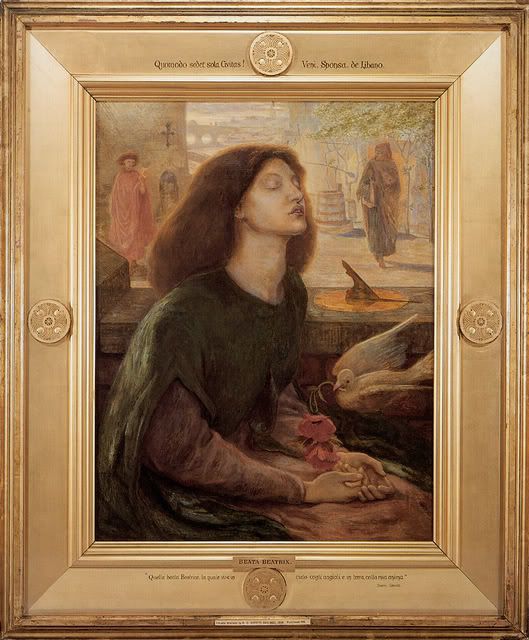
“Apostles of Beauty: Arts and Crafts from Britain to Chicago” is a new exhibit at the Art Institute of Chicago celebrating the Arts and Crafts movement. For those of you who would love to see Dante Gabriel Rossetti's "Beata Beatrix" in the flesh, this is your chance, as it's one of the pieces featured in the exhibit!
"Apostles of Beauty" features 187 "handcrafted, organic works by the movement's most notable practitioners." The pieces in the show are drawn from a variety of artistic disciplines, including ceramics, wood and metalwork, paintings, photographs and textiles.
In its overview of the exhibit, the museum's website calls the Arts and Crafts movement "one of the most politically progressive and aesthetically compelling artistic movements of modern times." It planted the seeds for the sort of critical thinking about modern living that has driven the green movement. Arts and Crafts connected organic thinking and living on a large scale for the first time, and demonstrated that the "beautiful and useful" as William Morris loved to say, were not mutually exclusive. As the museum's website so beautifully puts it:
The Arts and Crafts movement sprang from a rebellion against industrial life and mass-produced objects yet eventually united hand and machine in the service of beauty.
On a side note, it certainly seems like 2009 has been a great year for interest in Arts and Crafts and the Pre-Raphaelites. It would be interesting to know if there are actually more exhibits being held, or if it just seems like there are because I'm always looking for them! (I suppose I could find out if I had the time or discipline to research the issue). Could it be a bit of both?
"Apostles of Beauty" runs now through January 31, 2010.
Read more at The Art Instutute of Chicago's website.
Posted by
Margaret
at
1:53 PM
2
comments
![]()
![]()
Labels: art nouveau, arts and crafts, museums, news, rossetti, william morris
Thursday, October 22, 2009
John Knight's Pre-Raphaelite Photography
Photographer John Knight has a passion for the Pre-Raphaelites (and for vintage and fine art photography in general). Knight's specialty is the Art Deco period (his studio is actually called Art Deco Studio), but he began his work recreating Pre-Raphaelite images after using two models he felt strongly resembled Jane Morris and Lizzie Siddal. Since then, Knight has recreated a number of iconic Pre-Raphaelite images for modern audiences. 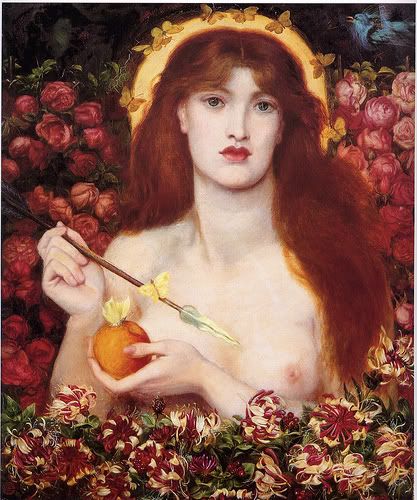
And here we have John Knight's photographic interpretation of the painting: 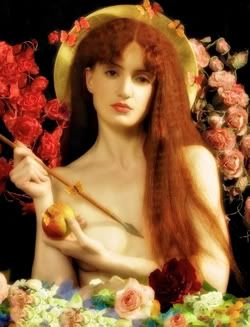
Of course, Knight uses a great deal of image editing software in order to reproduce the paintings, but it would be impossible to make them look much like the originals without it.
His interpretation of Frederick Sandy's "Love's Shadow" is spectacular, though it shies away from the energy and anger of the original. The girl in Knight's version is a quite a bit more coy and far less threatening than Sandys' (who you will recall is actually baring her teeth in the painting).
Knight's version: 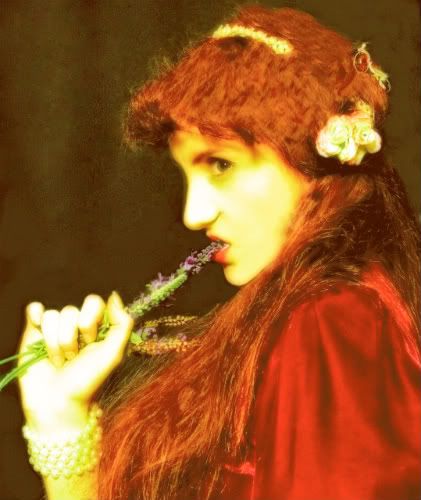
Anthony Frederick Sandys' version - teeth bared, and looking a bit vicious: 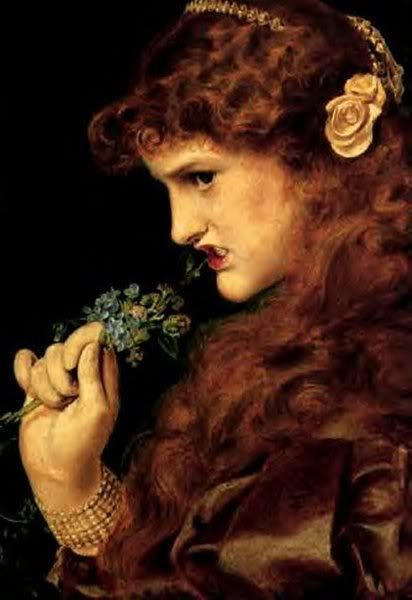
I asked Knight what drew him to Pre-Raphaelite art. He replied that
"the images created by the PRB are amongst the most enduring of all art works ever created. They touch the soul and the heart, they challenge the eye and they transport the viewer back...back to fantasy, to chivalry, to folklore and myth to the stories of our childhood and the dreams of our imagination."
I couldn't agree more!
Be sure to check out John Knight's website for more of his Pre-Raphaelite images. Many are quite extraordinary--I think my favourites are the Venus Verticordia (shown above) and Flaming June.
Posted by
Margaret
at
10:11 AM
6
comments
![]()
![]()
Labels: frederick sandys, photography, pre-raphaelites, rossetti
Monday, August 10, 2009
BBC 4 The Pre Raphaelites
For those of you living in the UK, the BBC has released a 3-part documentary series on the Pre-Raphaelites to coincide with Desperate Romantics. Since Desperate Romantics is rather short on historical context, be sure to watch the documentary alongside the costume drama, especially if this is your first introduction to the Pre-Raphaelites. 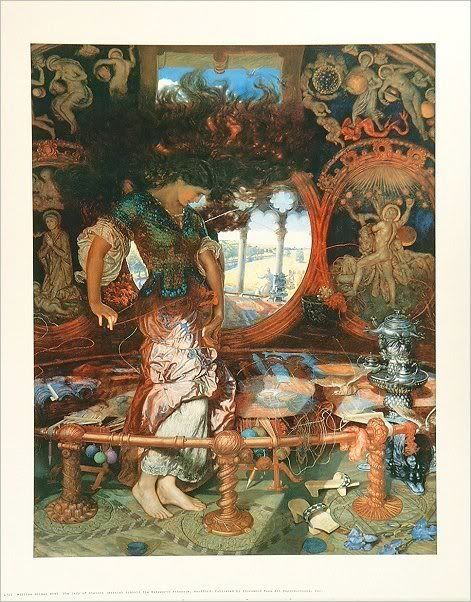
The documentary, entitled The Pre-Raphaelites: Victorian Revolutionaries, features author Jan Marsh (author of Pre-Raphaelite Sisterhood) and a number of other art historians discussing the PRB's rise to fame, their landscape art and the eventual commercialisation of their work.
I really enjoyed the series, although I found it a little annoying that they kept insisting that the Pre Raphaelite Brotherhood somehow "sold out" when they began to find a market for their art. The series really pushes the notion that the Pre-Raphaelites were somehow the first artists to commercialise their work (and that this was a betrayal of their earlier, nobler ideals). Artists and writers have always wanted to profit from their work. It's pure romantic fantasy to imagine that there was some golden age of art where everyone indulged in art for art's sake without an eye toward profits. The PRB simply lucked out by being in the right place at the right time, and they took advantage of the technology that was available to them. I'm quite sure that if Sir Joshua Reynolds had lived through the Victorian era, he too would have been hawking his lithographs right alongside the former members of the PRB. You will remember that even the socialist William Morris was a businessman! It seems very hard for the BBC to conceive of the possibility that one might simultaneously be a romantic revolutionary and hope to pay the rent.
For those of you living in the UK, several of the episodes are available in streaming video online through the BBC Pre-Raphaelites mini site.
Episode 2, which covers the Pre-Raphaelites approach to landscape art, will be aired again on August 11 at 10:00 pm.
Posted by
Margaret
at
8:24 AM
7
comments
![]()
![]()
Labels: millais, news, pre-raphaelites, reviews, rossetti, william holman hunt, william morris
Monday, August 3, 2009
Desperate Romantics - First Impressions
I finally had a chance to watch the first two episodes of BBC's Desperate Romantics with Javier last week. We both really enjoyed it. Overall, I found it highly entertaining (and yes, it was quite accurately described by its producer as "Entourage with easels"). The production was a bit weak on the historical front, but I suppose this was done by the writers to broaden the appeal of the series.
The series focuses on the early years of the Pre-Raphaelite Brotherhood and follows their rise to fame.
I was pleasantly surprised with the casting, particularly that of Lizzie Siddal. The actress who plays Lizzie not only resembles Siddal a great deal, but she also does an excellent job of bringing life and pathos to the character. John and Effie Ruskin are also well-cast, and are more developed than I had anticipated, although the endless speculation about what was wrong with their marriage always gets to me--honestly, nobody has any idea what the problem was (biographers seem to constantly return to the idea that Ruskin was disgusted by Effie's body hair, but how could they know?). Nevertheless, much like the rumours about Michael Jackson, I suppose this gossip is just too juicy for scriptwriters to pass up.
Unfortunately, the characterization of most of the other major players is rather simplistic, though it is in keeping with the rest of the shows' approach. Aidan Turner is handsome and energetic as Dante Gabriel Rossetti, if a bit one-dimensional. William Holman Hunt's character certainly seems to have drawn the short straw in terms of personality. Most biographers of the Pre-Raphaelites tend to consider Hunt a bit of a blowhard, but he's painted with such a broad brush in this production that it borders on the ridiculous. I hope that the writers will add some nuance to his character in the remaining episodes. Perhaps the most promising character so far is that of John Everett Millais, who is played by Samuel Barnett. Millais' character is quite endearing, and it looks like we will be seeing more of him in tonight's episode.
The character I could sort of do without is Fred Walters--a fictional hanger-on that is meant to function as a bit of a window into the lives of the PRB. He's sort of an amalgamation of a number of real-life members of the brotherhood, but I really wish that they had included William Michael Rossetti in the story instead. William Michael has always seemed quite interesting to me, and he certainly did a great deal to contribute to the visibility of the Brotherhood. I suppose the writers felt that adding in another member of the Rossetti family would rob Dante Gabriel of some of his mystique, but I digress.
Overall, I'm definitely enjoying the series. It's so nice to finally see the lives of the Pre-Raphaelites dramatized! Desperate Romantics may fall a bit short on historical accuracy, but the story of the Pre-Raphaelite Brotherhood is so inherently exciting that the show can't help but be enormously entertaining.
I'd be extremely interested to hear from others who've had a chance to see the first few episodes. What were your first impressions? Were you pleased or disappointed? Do you think the show will revive interest in the Pre-Raphaelites?
Posted by
Margaret
at
11:31 AM
11
comments
![]()
![]()
Labels: millais, news, pre-raphaelites, reviews, rossetti, ruskin, william holman hunt
Monday, July 6, 2009
The Pre-Raphaelites Brought to Life at Preraphaelites.org
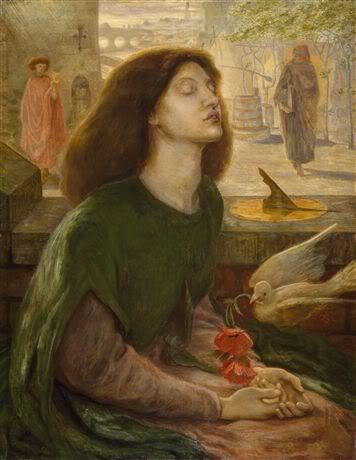
The Birmingham Museum of Art (which houses the largest public collection of Pre-Raphaelite Art) has just unveiled their new website, Preraphaelites.org, which promises to offer the most intimate experience of the Pre-Raphaelites work that can be achieved outside of visiting the museum.
The website uses Microsoft’s Silverlight technology, which allows the viewer to expand the artworks as much as possible while maintaining the integrity of the image. It is a spectacular tool, and I can't wait to see more museums adopt this method of cataloguing the works in their collections.
I used Silverlight to take a closer look at Dante Gabriel Rossetti's Beata Beatrix, and I have to admit it was an extraordinary experience. The detail is incredible! I have only had the opportunity to view a few Pre-Raphaelite artworks in person, and this technology does allow you to get much closer to the work than they would ever let you get in person. (Even more than in France, where they are extremely permissive of museum guests getting quite close to the paintings!).
In addition to allowing you to see the finest details of many of the works in their collection, the website also points you to related works. In the case of Beata Beatrix, this leads you to a number of sketches of the work. They also seem to offer more detailsa about the works than other museum websites do, and if you register for the website, you can even discuss the paintings with other art fans online.
I originally heard about this project thanks to an email from the Communications Officer for Environment & Culture at the Birmingham City Council. I am so glad they emailed me and that the Council is getting the word out about this great resource! I can see why the Birmingham City Council is quite proud of this site. It really offers a unique opportunity for art lovers across the globe to see these works "up close and personal" and I think the site will generate a lot of tourism once people see what the museum has to offer.
Of course, nothing can replace the experience of seeing these works in person, but this new website does get awfully close. And for those of you planning to visit Birmingham Museum and Art Gallery, I strongly urge you to visit this website first. If there are any artworks you are hoping to see in person, you can actually request a viewing through the website! This is an amazing service. I'm used to having to write to museums, but this tool makes the entire process so much easier (plus it makes it seem like they actually want to let you see the works!). This is especially important to do if there are any lesser-known sketches that you would like to see in person, as these might be in storage at the time of your visit. Again, I can't possible stress enough what a great resource this is!
Kudos to the Birmingham Museum and Art Gallery for these great tools. It's so great to see museums putting their catalogue online and taking advantage of new technology that compliments, rather than detracts from, the artwork. I am a firm believer that giving public access to artwork generates a tremendous amount of interest. I hope this great site makes a new generation fall in love with the work of the Pre-Raphaelites.
Image courtesy Birmingham Museum of Art.
Posted by
Margaret
at
8:34 AM
9
comments
![]()
![]()
Labels: museums, pre-raphaelites, reviews, rossetti, technology
Monday, June 29, 2009
Desperate Romantics
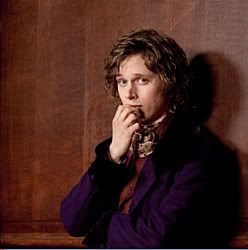
At long last, some additional news has broken about the BBC television adaptation of Franny Moyle's Pre-Raphaelite potboiler, Desperate Romantics. After months with no news, cyberspace finally has a fresh injection of stories about the much-anticipated series.
One of the more interesting articles I came across was Rapid Talent's interview with Samuel Barnett, who will be playing John Everett Millais. Barnett describes getting acquainted with his character through field trips to the National Gallery:
"I like all sorts of art, that's why I love wandering around The National Gallery. I really admire paintings that look like an actual snapshot – I think that's just extraordinary. That's what's so special about Millais: flesh – people's actual skin – looks real, for example in The Order Of Release and Christ In The House Of His Parents; it's photographic, it doesn't matter how close you get to the painting, you don't see the brushwork. With Millais's paintings it's microscopic; when he does hair it's extraordinary, you can see every strand. His paintings are my favourites – not just because I'm playing him – I think he's the best artist of the group, technically and also emotionally."
I would have to agree, though, as you all know, I have a great appreciation for Burne-Jones and Rossetti as well.
Although I'm a little disappointed that the BBC feels it's necessary to portray the Pre-Raphaelites as prototypes for modern models and rock stars, I suppose it makes it makes sense from a marketing perspective. And, in all honesty, I must admit that I was always drawn to that aspect of their story. As Barnett points out, the Pre-Raphaelites came on the scene just as the public was gaining greater access print publications than ever before:
"You don't have to know anything about the period or the artists; it's a human story and a 'sex, drugs and rock 'n' roll' story as well: this was the period when supermodels and celebrity was born. The use of the printing press meant everyone, nationally and internationally, could see these guys' paintings and the models they used, that was a first – art had never had exposure like that before."
You can read the full story at Rapid Talent UK.
Also, special thanks to Grace at The Beautiful Necessity for bringing to my attention the fact that news stories about Desperate Romantics are finally starting to get out!
Posted by
Margaret
at
8:17 AM
7
comments
![]()
![]()
Labels: edward burne-jones, millais, news, pre-raphaelites, rossetti, ruskin
Thursday, June 25, 2009
Pre-Raphaelite Art at the Delaware Art Museum
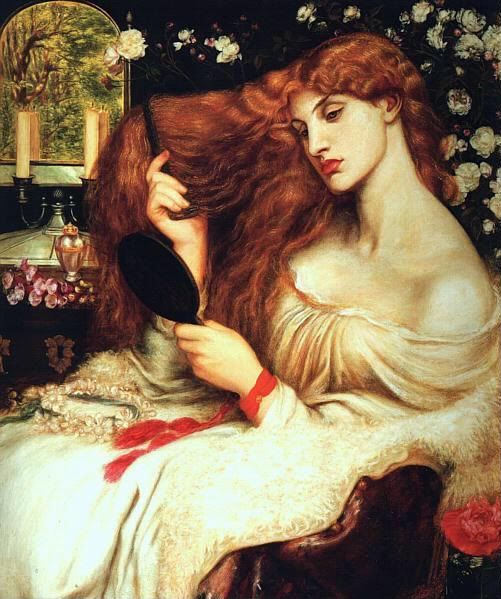
I'm always on the lookout for great Pre-Raphaelite art online, and yesterday I came across the Delaware Art Museum's fabulous Pre-Raphaelite art gallery, which features the collection of Samuel and Mary Bancroft. The Delaware Art Museum has the largest permanent collection of Pre-Raphaelite works in the United States. The museum maintains their collection through the generous support of the aptly-named "Rossetti Circle" of art patrons. I would definitely join if I lived anywhere near Delaware! Anyway, it's a lovely, well put together website with an extensive collection of photos of Pre-Raphaelite art and art objects. I highly recommend taking a moment to enjoy what they have to offer.
I was particularly impressed by the Delaware Art Museum's education packet on the art of the Pre-Raphaelites. It's available for download here. This curriculum package covers the Pre-Raphaelites, William Morris and the Arts and Crafts Movement, The Aesthetic Movement--and pretty much everything else that is important to the study of Pre-Raphaelite Art. It's one of the best resources of it's kind that I have come across, and far superior to many books that I've read on the subject! If you are looking for some more information on the topic of the Pre-Raphaelites, it's definitely a great place to start.
Posted by
Margaret
at
8:22 AM
8
comments
![]()
![]()
Labels: arts and crafts, museums, pre-raphaelites, reviews, rossetti, william morris
Sunday, February 8, 2009
Cast of "Desperate Romantics" announced by the BBC
The BBC Press Office has finally released the casting information for their upcoming series, Desperate Romantics. Most of the actors historically inspired TV dramas are much better looking than their historical counterparts and I'm not complaining. However, the BBC definitely took some rather extreme artistic liberties with this one.
First up: Dante Gabriel Rossetti will be played by Aiden Turner. We all know that Rossetti was a bit of a lady killer, but he wasn't exactly top model material. The producers have chosen to gloss over this a bit and have chosen an impossibly attractive young man to play Rossetti. While I fail to see much of a resemblance between him and Rossetti (other than the fact that both of them have brown hair!), I'm pretty sure Rossetti would approve. After looking at his photograph, take a look at his self-portrait. Rossetti doesn't seem to have had a problem with portraying himself as more attractive than he actually was (though, in his defence I'm sure years of drug abuse had taken a toll on his boyish good looks in this photo).
Dante Gabriel Rossetti, in the flesh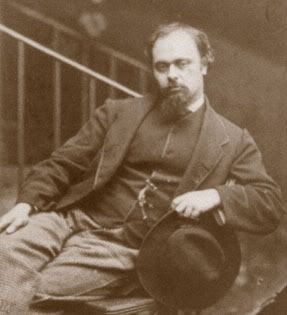
Rossetti's self portrait: 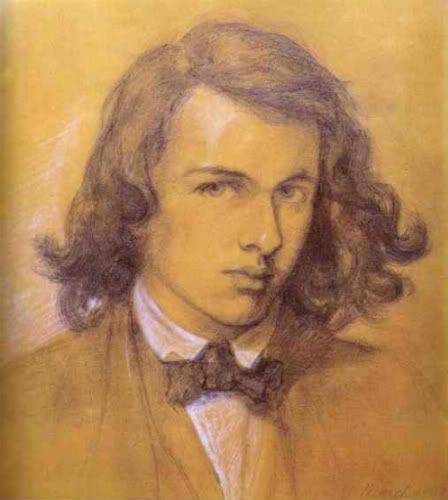
And finally, his cinematic alter ego : 
Correction: it's not that Aidan Turner, it's this one:
(And thank you to whoever pointed out which Aidan Turner will actually be starring in Desperate Romantics! A little less soap-opera-ish and a lot more believable.)
And now for the rest of the cast.
Tom Hollander (who bears little resemblance to John Ruskin--for one thing, he's a bit chubby and Ruskin was practically anorexic) will be playing Ruskin, the famous art critic and patron of the Pre Raphaelites. This casting decision still makes sense to me,though, as Hollander often plays snobby, self-absorbed types. At the same time, I hope he doesn't overdo it. Ruskin was certainly interesting, even if he was obsessed with his work and had a rather odd way of relating to women.
In more casting news, Samuel Barnett will be playing John Millais, and Zoe Tapper will be playing Effie Ruskin (who later leaves Ruskin to be Mrs. Millais).
Amy Manson has been cast as Pre-Raphaelite "stunner" Lizzie Siddal, Sam Crane as Fred Walters and Jennie Jacques will play Annie Miller. Rafe Spall will also take a turn as PRB founding member William Hunt.
All in all, I predict that the script will be frothy melodrama and the cast will be easy on the eyes. Not a problem, as far as I'm concerned. There's no denying that the Pre-Raphaelites are ripe for soap opera-esque treatment. I just hope that the series will revive public interest in the Pre-Raphaelite and Arts and Crafts movements.
Posted by
Margaret
at
10:14 AM
20
comments
![]()
![]()
Labels: lizzie siddal, pre-raphaelites, rossetti, ruskin, william holman hunt
Monday, January 19, 2009
Belmont Lodge, an historic building with ties to the Pre-Raphaelite Movement, is threatened with demolition
Belmont Lodge, an historic building in Bognor Regis with ties to the Pre-Raphaelite movement, has been threatened with demolition.
The lodge, which dates back to the Regency period, was the home of William Shakespeare Burton. Burton's best-known Pre-Raphaelite-inspired work is The Wounded Cavalier."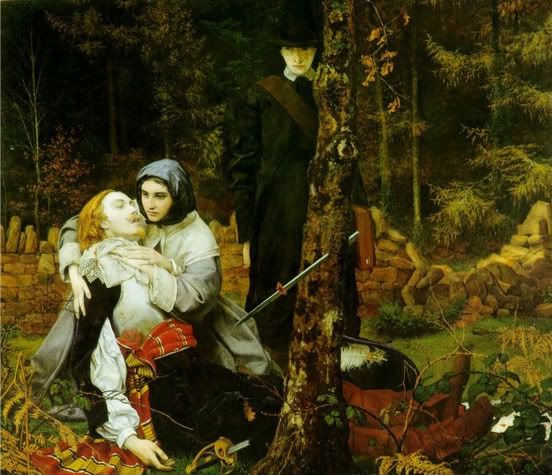
Dante Gabriel Rossetti stayed in the Lodge's former coach house for a year, during which he produced as many as ten paintings, including the famous Astarte Syriaca.
It is currently being proposed that the lodge be torn down and an apartment complex erected in its place. What a shame. Let's hope that people in the area make a fuss about the plans, though I'm not sure how likely that is, since the building is neither well-known, nor listed as an historic building.
You can read more about the proposal in the Bognor Regis Observer.
Image: "The Wounded Cavalier," by William Shakespeare Burton, 1855.
Posted by
Margaret
at
10:17 AM
4
comments
![]()
![]()
Labels: news, pre-raphaelites, rossetti
Wednesday, January 14, 2009
Desperate Romantics by Franny Moyle
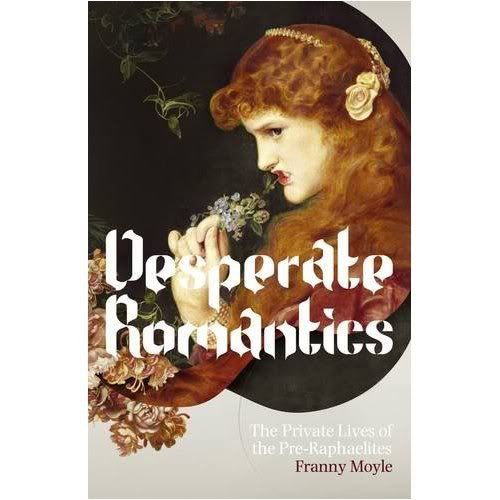
Franny Moyle's new book, Desperate Romantics, catalogues the lives and loves of the Pre-Raphaelites, while occasionally touching on their art. The book, which serves as the inspiration for the upcoming BBC miniseries of the same name, sounds like it will be a delight for those looking to dwell on the shallower aspects of the Pre-Raphaelite movement.
First, I will confess that the bohemian lifestyle of the Pre-Raphaelites has held a certain fascination for me ever since I first picked up Beth Russell's Traditional Needlepointand suddenly found myself entranced by the beauty of Morris and Rossetti's art and the sordid details of their personal lives. Whether for good or ill, the countless affairs, intrigues, love triangles and suicides that pepper the Pre-Raphaelite movement have undeniably added to their allure.
It still seems a shame that the book ignores the Pre-Raphaelites' art almost entirely, in favour of tabloid coverage of their exploits. There is so much more to the Pre-Raphaelite vision than sultry models and randy artists. William Morris himself was a fascinating man with beautiful ideas that are still pertinent today. The same is also true for the inspiring John Ruskin, who is sidelined as a mere deviant in Moyle's work. In her defence, however, I notice that Moyle is a television producer, which probably explains her conviction that sex is the best way to sell art. And perhaps she's right. It certainly worked for me. Today my interest in the Pre-Raphaelites goes far beyond their sordid personal lives, but in the beginning, their fascinating lives were instrumental in drawing me into their world.
For more information, read the Times review of Desperate Romantics
Posted by
Margaret
at
10:28 AM
8
comments
![]()
![]()
Labels: books, jane morris, news, rossetti, ruskin, william morris
Thursday, December 25, 2008
Old English Christmas Carol
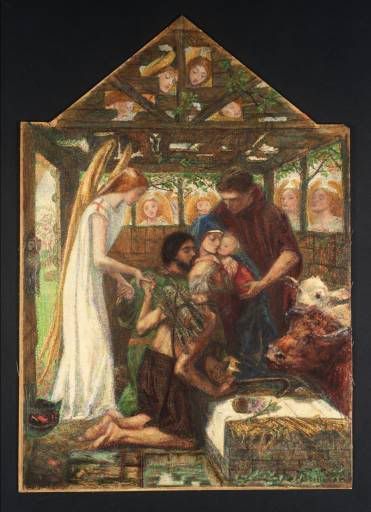
Merry Christmas to all! When I was a child this was probably my favourite Christmas Carol. Long before I saw my first Disney movie, I was fascinated by the idea of talking animals, so the idea that animals could speak on Christmas Eve was particularly attractive to me. I still remember it from a little cassette tape and book of Christmas Carols that I carried around with me for MONTHS leading up to Christmas. The tape was played so much that it always warbled during this song (and during my other favourites, the "Wassailing Song," "Good King Wenceslas" and "The Holy and the Ivy". I guess even then I had a thing for Old English Carols!
The Friendly Beasts
Jesus, our brother, kind and good,
Was humbly born in a stable rude;
And the friendly beasts around Him stood.
Jesus, our brother, kind and good.
"I," said the Donkey, shaggy and brown,
"I carried His mother up hill and down;
I carried His mother to Bethlehem town."
"I," said the Donkey, shaggy and brown.
"I," said the Cow, all white and red,
"I gave Him my manger for His bed;
I gave Him my hay to pillow His head."
"I," said the Cow, all white and red.
"I," said the Sheep, with the curly horn,
"I gave Him my wool for His blanket warm;
He wore my coat on Christmas morn."
"I," said the Sheep, with the curly horn.
"I," said the Dove, from the rafters high,
"I cooed Him to sleep that He should not cry;
We cooed Him to sleep, my mate and I."
"I," said the Dove, from the rafters high.
Thus every beast by some glad spell,
In the stable dark was glad to tell
Of the gift he gave Emmanuel,
The gift he gave Emmanuel.
Image courtesy of the Tate Gallery. It's "The Adoration" by Dante Gabriel Rossetti, and was painted between 1858 and 1864. I had actually never seen this painting before today! I just love the strong Medieval quality that it has. I'm so glad I found it!
Posted by
Margaret
at
4:19 PM
11
comments
![]()
![]()
Labels: medieval, music, pre-raphaelites, rossetti
Friday, December 12, 2008
Death, Taxes and Pre-Raphaelite Art
What do death and taxes have to do with Pre-Raphealite Art?
It seems that in today's tough economic times, Britain's millionaires are turning to their art collections when it comes time to pay the tax man. The U.K. Treasury recently accepted an art collection worth over £15 million ($22.4 million) as payment in lieu of inheritance tax. The collection of rare artworks includes paintings by J.M.W. Turner (including the watercolor Carisbrook Castle) as well as some fabulous works by members of the Pre-Raphaelite Brotherhood, including Sir Edward Burne-Jones and Dante Gabriel Rossetti. 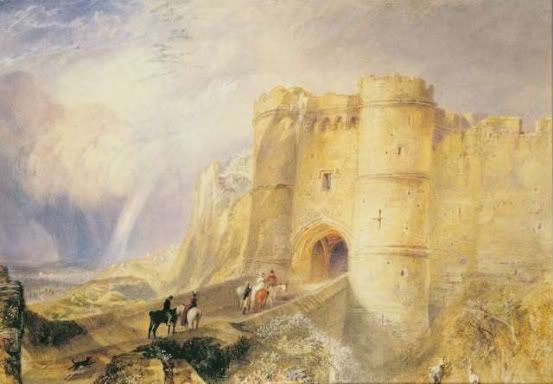
Among the more eccentric items in the collection is the embroidered undershirt owned by British naval hero Lord Horatio Nelson--now there's a conversation piece.
The good news is that at least a few of these objects will now be in the public domain. The Treasury has announced that several of the paintings will be returning to the five National Trust houses from which they originally come.
For more information: U.K. Receives £15M Collection in Lieu of Death Duties at ArtInfo.com
Image: JMW Turner, Carisbrook Castle, 1827(in Public domain)
Posted by
Margaret
at
9:49 AM
7
comments
![]()
![]()
Labels: edward burne-jones, news, pre-raphaelites, rossetti
Wednesday, October 8, 2008
The Pre Raphaelites and Their World
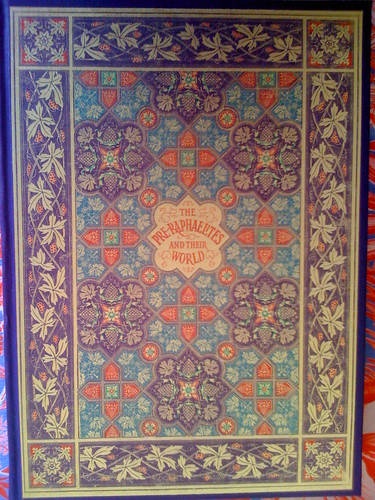
I've really been missing the University library lately. I need to get an alumni membership, but I'm afraid I haven't gotten around to that yet. But as you can see from the picture above, I am starting my own collection of Pre-Raphaelite materials!
The other day my husband and I took a stroll near our home in Edmonton to enjoy the last of the lovely fall weather. He spied this beautiful book in a shop near Whyte Avenue and made me get it! We had been scouring the used book stores near our house for books on the Pre-Raphaelites. Generally I don't see much of anything, but this book was quite a find.
The Pre-Raphaelites and Their World is William Michael Rossetti's reminiscences about his brother and the rest of the members of the Pre-Raphaelites. For those of you who are familiar with William Holman Hunt's more gossipy version of the PRB's history, William Rossetti's account is something of an adjustment. His book is far less sensational, but as a historian, I think it's a great deal more reliable! Although William acknowledges that he cannot recall minute details about conversations that had taken 50 years before (unlike Holman Hunt, who transcribed full conversations), Rossetti fills the book with fabulous anecdotes that reveal a different, more thoughtful side of the Brotherhood. I would hugely recommend it to anyone who wants to learn more about the Pre-Raphaelites.
Of course, one of the main things that stood out to me immediately about this book was its beauty. It's a 1995 Folio edition of William Michael Rossetti's writing, and the whole volume is filled with lovely photographs (most by Margaret Cameron) and Pre-Raphaelite paintings. It's a truly lovely book and it's so nice to see a relatively new book that has been so beautifully made (it even came with a lovely little case to keep it looking pretty!). I don't think it's original owner had ever even opened it--I was really lucky!
So far, my favourite aspect of the book is William Michael Rossetti's recollection of his childhood. The Rossetti household must have been such an exciting place to grow up. No wonder that Christina and Dante Gabriel were such prolific writers and artists! Their home was really the ultimate in terms of a nurturing environment (and as I mentioned in an earlier post, this was really true of Millais' home as well). How lucky the Rossetti children were! They had the chance to actually converse with all of their father's artistic and literary friends from the time they were small children. I love William's story about four year old Dante Gabriel terrifying the milkman, who "saw a baby making a picture." Perhaps he was as much a prodigy as Millais, though it's hard to know.
Although this book doesn't offer theories about the Janey-Topsy-Rossetti love triangle, I appreciate its more subdued approach. There are so many books that dwell on the scandals of the Pre-Raphaelites that it is refreshing to be reminded of the exciting ideas, talents and aspirations that this group of people had.
Posted by
Margaret
at
6:25 PM
10
comments
![]()
![]()
Labels: books, pre-raphaelites, rossetti
Tuesday, September 23, 2008
The Original Members of the Pre Raphaelite Brotherhood
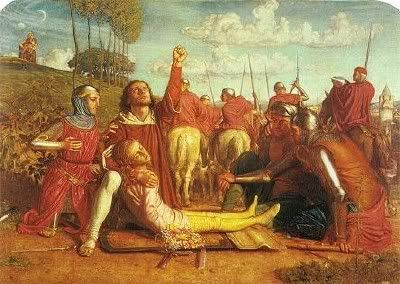
Last week I wrote a post about the Pre-Raphaelite that led to some questions about the original Pre-Raphaelite Brotherhood. I thought today I would write a little bit about the founding members of the PRB, and the major players among them.
Although there were seven original members of the Pre-Raphaelite Brotherhood, the founding members of the Brotherhood were really Dante Gabriel Rossetti, William Holman Hunt and John Everett Millais. These three have had the most lasting influence from among the original seven, and there work is the best known. After the idea for the PRB had been developed by Rossetti, Hunt and Millais, Rossetti invited his brother William, a clerk at the Inland Revenue Office, into the group as well. Interestingly, at the time the the Brotherhood was founded, William was neither a painter nor a serious writer. Nevertheless, he was the founding member's brother, and I suppose you can't blame Rossetti for wanting to include his family members!(Christina Rossetti was also an important part of the group, though she was excluded from the Brotherhood by reason of her sex).
Thomas Woolner, the fifth member of the PRB, was a sculptor who was introduced to the Brotherhood by D.G. Rossetti. In his biography of Rossetti, Evelyn Waugh is anxious to point out that Thomas Woolner married a Waugh (Alice Waugh). So too, did William Holman Hunt--twice. He first married Fanny Waugh, and when she died in childbirth, he married her sister, Edith. This was illegal in Britain at the time and he had to travel abroad in order to marry her!(Waugh, 35). No wonder Waugh was so interested in the Pre-Raphaelites!
James Collinson, a convert to Roman Catholicism had torrid on again/off-again relationships with both Christina Rossetti and the Catholic Church--both of which often seemed to hold far more interest to him than his painting--was the next to join. Frederick George Stephens was the seventh and final member of the original group. Stephens was a student of William Holman Hunt and his membership in the Brotherhood may have been due as much to Rossetti's superstition (a desire for a perfect seven-member group) as to any supposed artistic contribution from Stephens.
Source consulted: Evelyn Waugh. Rossetti, His Life and Works. London: The Folcraft Press, 1969.
Image: William Holman Hunt, Rienzi Vowing to Obtain Justice
Posted by
Margaret
at
4:58 PM
5
comments
![]()
![]()
Labels: millais, pre-raphaelites, rossetti, william holman hunt


